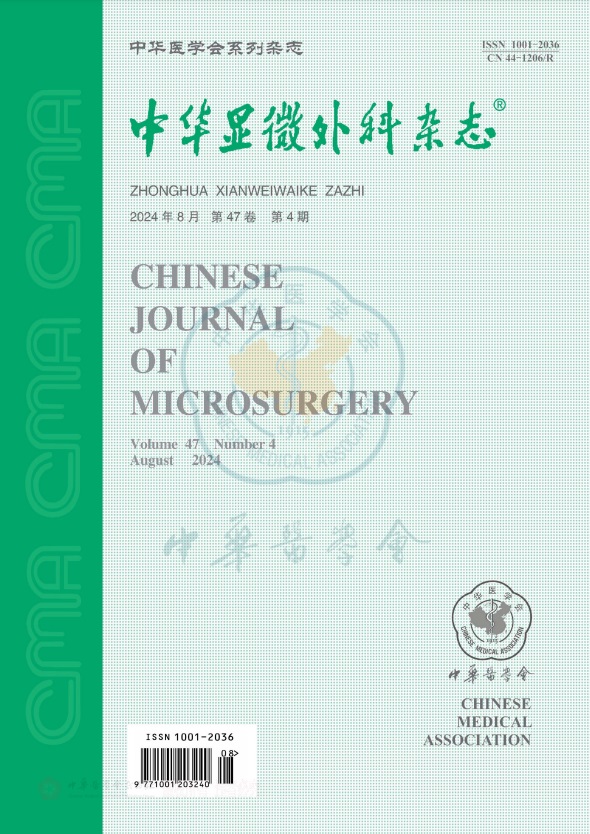Analysis of the causes and the countermeasures for the serious complications after perforating pedicle flap of lower leg
引用次数: 0
Abstract
Objective To analysis causes of the serious complications after the operation of the lower leg perforator pedicle screw flap, and to explore the corresponding countermeasures. Methods From June, 2012 to August, 2016, 60 cases of soft tissue defect of ankle and foot were repaired with propeller flaps pedicled with perforator of lower legs. with the area were soft tissue defect ranged from 3.0 cm×2.0 cm to 19.0 cm×9.0 cm, and all with bone exposure. Two cases of traumatic tissue defect, 7 cases were chronic osteomyelitis of the distal tibia, 13 cases were incision infection and necrosis after the operation of ankle joint fracture and Pilon fracture, 10 cases were simple incision necrosis after calcaneal fracture, 18 cases were calcaneal osteomyelitis, 1 case were soft tissue defect after the ankle tumor operation, 6 cases were soft tissue necrosis after the Achilles tendon rupture, and 3 cases were soft tissue defect of the dorsum with infection. The posterior tibial artery perforator pedicled propeller flap was used in 18 cases. The pedicle of the vascular pedicle was 6.0-18.0 cm from the medial malleolus, the flap rotation was 135°-180°. There were 42 cases of the perforator pedicle propeller flap of the peroneal artery, 5.0-18.0 cm from the pedicle of the vascular pedicle and 120°-180° rotation in the flap. The area of the flap was 9.0 cm×3.0 cm-34.0 cm×18.0 cm. There were 32 cases of direct suture in the donor site and 28 cases of free skin grafting. Results The color, swelling, elasticity, capillary reaction and healing of donor site were observed after operation. There was no flap ischemia occurred in 60 patients. Fourteen cases had venous reflux obstruction, all of which had swelling above II degree, 8 cases had swelling above III degree with obvious purple blood stasis, resulting in partial flap necrosis in 4 cases, all necrosis in 1 case, including 4 cases of free skin grafting, 1 case of flap transplantation and repair. There were 3 cases of necrosis after skin grafting in the flap area, all of which were partial necrosis. There was case of necrosis of the wound surface after direct suture of the donor site and 1 case of skin disintegration after disassembly, and all wounds healed after the replacement of the wound and the external use of the dried blood powder. All the 60 patients were followed-up for 12 to 30 (mean, 24.5)months. The flaps survived and the donor site scars healed well. The range of motion of the ankle was from -10°to 10°(mean, 5.6 °) and the flexion of the plantar was from 20 °to 50 °(mean, 37.8 °). Fourteen patients with venous reflux disorder were followed up for 15 to 28(mean, 22.3)months. The flap and skin graft survived well. Ankle dorsiflexion ranged from -10° to 10 °(mean, 2.4 °) and plantar flexion from 20° to 45 °(mean, 35.6 °). There was no obvious limp in walking. Conclusion Although the overall effect of the lower leg perforator pedicle propeller flap to repair the soft tissue defect of the foot and ankle is satis-factory, there are still various serious complications, which are mainly due to iatrogenic. Doctors should strictly follow the basic principles of skin flap surgery from preoperative to postoperative, and during operation and postoperative man-agement, so as to reduce the incidence of complications. Key words: Lower leg; Perforator vessel; Propeller flap, perforator flap; Ankle and foot; Complication小腿蒂皮瓣穿孔后严重并发症的原因分析及对策
目的分析小腿穿支椎弓根螺钉皮瓣术后严重并发症的原因,探讨相应的对策。方法自2012年6月至2016年8月,应用以小腿穿支为蒂的螺旋桨皮瓣修复60例足踝软组织缺损。面积为3.0cm×2.0cm~19.0cm×9.0cm的软组织缺损,均为骨外露。外伤性组织缺损2例,胫骨远端慢性骨髓炎7例,踝关节骨折和Pilon骨折术后切口感染坏死13例,跟骨骨折后单纯切口坏死10例,跟骨骨髓炎18例,脚踝肿瘤术后软组织缺损1例,6例为跟腱断裂后软组织坏死,3例为感染性背侧软组织缺损。应用胫后动脉穿支带蒂螺旋桨皮瓣18例。血管蒂距内踝6.0-18.0cm,皮瓣旋转135°-180°。腓动脉穿支蒂螺旋桨皮瓣42例,距血管蒂5.0-18.0cm,皮瓣旋转120°-180°。皮瓣面积9.0cm×3.0cm~34.0cm×18.0cm,供区直接缝合32例,游离植皮28例。结果术后观察供区颜色、肿胀、弹性、毛细血管反应及愈合情况。60例患者未发生皮瓣缺血。静脉回流性梗阻14例,均为Ⅱ度以上肿胀,Ⅲ度以上肿胀8例,有明显紫色瘀血,导致皮瓣部分坏死4例,全部坏死1例,其中游离皮移植4例,皮瓣移植修复1例。皮瓣区植皮后坏死3例,均为部分坏死。供区直接缝合后创面坏死1例,拆散后皮肤崩解1例,更换创面并外用干血粉后全部愈合。术后随访12~30个月,平均24.5个月,皮瓣成活,供区瘢痕愈合良好。踝关节的活动范围为-10°至10°(平均5.6°),足底屈曲范围为20°至50°(平均37.8°)。对14例静脉回流障碍患者进行了15~28个月(平均22.3个月)的随访,皮瓣和皮片均存活良好。踝关节背屈范围为-10°至10°(平均2.4°),跖屈范围为20°至45°(平均35.6°)。走路时没有明显的跛行。结论小腿穿支带蒂螺旋桨皮瓣修复足踝软组织缺损,虽然整体效果满意,但仍存在各种严重并发症,主要是医源性并发症。医生应严格遵循皮瓣手术的基本原则,从术前到术后,在手术和术后管理中,以减少并发症的发生。关键词:小腿;穿孔器容器;螺旋桨襟翼、穿孔襟翼;脚踝和脚;并发症
本文章由计算机程序翻译,如有差异,请以英文原文为准。
求助全文
约1分钟内获得全文
求助全文
来源期刊
CiteScore
0.50
自引率
0.00%
发文量
6448
期刊介绍:
Chinese Journal of Microsurgery was established in 1978, the predecessor of which is Microsurgery. Chinese Journal of Microsurgery is now indexed by WPRIM, CNKI, Wanfang Data, CSCD, etc. The impact factor of the journal is 1.731 in 2017, ranking the third among all journal of comprehensive surgery.
The journal covers clinical and basic studies in field of microsurgery. Articles with clinical interest and implications will be given preference.

 求助内容:
求助内容: 应助结果提醒方式:
应助结果提醒方式:


